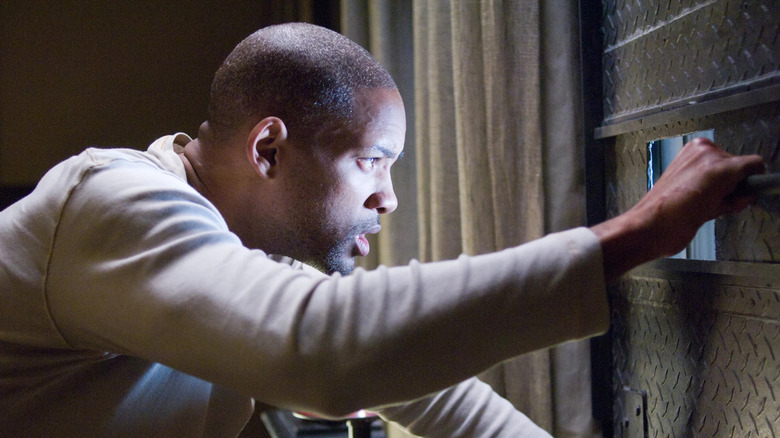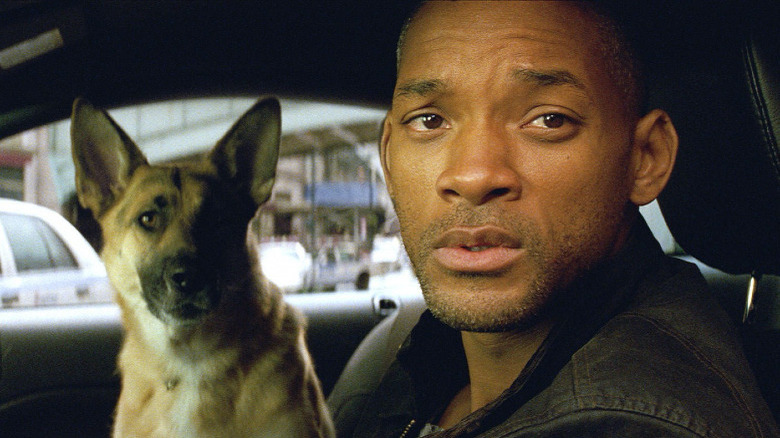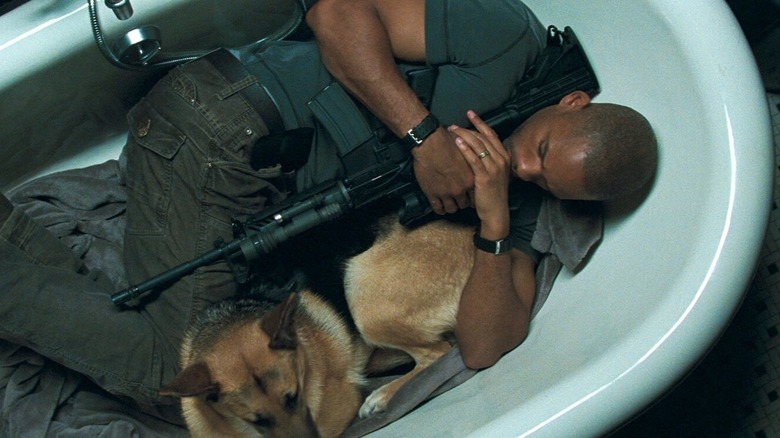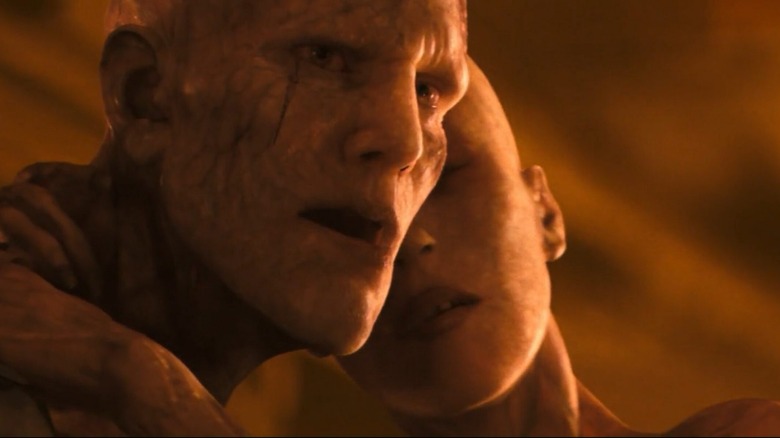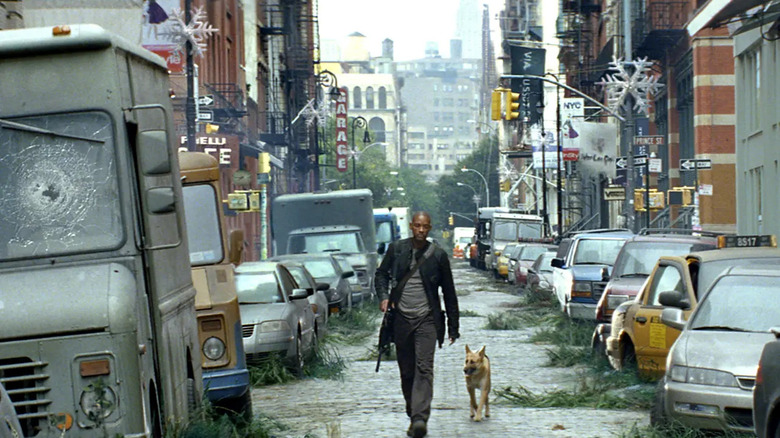I Am Legend Ending Explained: The Ending We Got (And The One We Didn't)
When "I Am Legend" was released in 2007, most people watching in crowded theaters probably never thought they'd see its awesome vistas of a deserted, windswept Manhattan in real life. Those images were chilling enough originally but take on an extra poignancy when revisited in a pandemic-era world, now that we've all gotten a glimpse of what an apocalypse might actually look like (albeit one without dodgy CGI mutants).
It's also strange watching a Will Smith movie after you-know-what at the 2022 Oscars ceremony. When it came out in 2007, "I Am Legend" was Smith at his most relatable, charismatic, and assured, carrying a blockbuster with a $150 million price tag almost single-handed with his sheer presence and star power. His journey to being taken seriously as an actor was an arduous and not always successful one, but the film marked the sweet spot in his transition. It's a big tentpole sci-fi movie with the spectacle of "Independence Day" but also a hefty leading role that Smith grabbed with both hands.
Smith's performance in the film remains one of his best, following in the footsteps of Vincent Price ("The Last Man on Earth") and Charlton Heston ("The Omega Man") in the third big screen adaptation of Richard Matheson's 1954 novel "I am Legend." For the initial hour, it is also the best adaptation to date despite its CGI, which looked terrible even when the movie first came out. Then we get to the ending, which is where the wheels come off. Let's dig into it.
So what happens in I Am Legend again?
"I Am Legend" opens with breaking news: Dr. Alice Krippin (Emma Thompson) reveals that she has successfully reprogrammed a virus to cure cancer. Skip to three years later, and the streets of Manhattan are completely devoid of people with nature starting to reclaim the once-great city. The "Krippin Virus" has not only decimated the world's population, but it has also turned the surviving infected into savage nocturnal creatures known as Darkseekers.
As we gaze in astonishment at this terrible but strangely beautiful sight, a red muscle car zooms along an empty street. Driving it is Dr. Robert Neville (Will Smith), out hunting deer with his faithful dog, Sam. Neville is the only person left alive in the city, a former U.S. Army virologist who lost his wife and daughter during the chaotic evacuation of the island three years prior. Now every day at noon he makes his way to a pier, the spot specified in his daily broadcasts to any other survivors out there who might be listening. For a little bit of company, he has also decorated his usual haunts with mannequins whom he greets and chats with as he goes about his routine in the deserted metropolis. At night, he hunkers down with his dog and listens as the Darkseekers emerge from the shadows and rage in the streets.
Neville is immune to the virus and he is still working on a cure using his own blood. When he gets some promising results, he captures a female Darkseeker to try out his serum. This enrages the Alpha Male, the unwilling trialist's mate, and the next day the creatures set a trap for Neville as payback. He is knocked unconscious, only waking at sundown.
Neville's 'legend' explained
Freeing himself from the trap, he and Sam are attacked by a pack of infected dogs. His faithful pooch is bitten defending her master and he realizes he must put her down before she turns, too. Overcome with grief and anger, Neville heads out into the night to take down as many Darkseekers as he can. He mows down a bunch in his car but the creatures manage to flip the vehicle. It looks like curtains for our hero.
He awakens back at home where he meets his saviors: Anna (Alice Braga), a Brazilian woman, and a young lad named Ethan (Charlie Tahan), two other survivors who arrived in town following his radio broadcasts. Anna wants Neville to go with them to a safe zone in Vermont, but he doesn't believe it exists. Besides, he wants to stick around and keep working on his cure.
Neville figures out that lowering the Darkseeker's temperature might increase the effectiveness of the serum but kill the test subject in the process. That's when we find out, via a wall full of photos, that he has experimented on dozens of the creatures before. Night falls again and the Darkseekers storm the house, having followed Anna the previous night.
Retreating to Neville's basement lab, they see that the serum is working and the patient is turning human again. However, before they can celebrate, the creatures burst into the room. Neville takes a sample of the cured Darkseeker's blood and gives it to Anna, hiding her and the boy in a coal chute. He then protects them and the cure by blowing himself and the creatures up with a grenade.
Anna and Ethan arrive at the safe zone with the cure. In a voiceover, Anna says that humanity's survival is Neville's legacy, and this story is his legend.
Richard Matheson's I Am Legend
This ending of "I Am Legend" is pretty bog-standard Hollywood stuff: The flawed hero lays down his life to save a woman and a kid, and humanity as a whole. Neville sacrificing himself doesn't feel too out of character because he has nothing to live for, other than curing the virus. Still, this conclusion does seem very cut-and-paste after the powerful opening hour of the movie. Even worse, it almost completely inverts the whole point of Richard Matheson's novel.
Things get more interesting when you compare it to the ending that director Francis Lawrence originally had in mind, which was closer in tone to Matheson's story. The latter's infected (or "vampires") were far more human-like, to the extent that Neville gets romantically involved with one before she admits that she's a spy sent to observe him. He has killed many of her kind before, including her husband. In the end, he is captured and awaits execution, looking out at the vampires who view him with the same fear and hatred he once reserved for them. As he takes his own life with fast-acting poison, Neville reflects on how he will become a legend and a cautionary tale to this new society taking over the world, much like old-school vampires once were to humans.
It is a far darker ending with a huge perception change for the reader as we realize, as Neville does, that he has become a monster himself in his obsessive drive to find a cure. The original ending of Lawrence's "I Am Legend" veered a little closer to Matheson's downbeat conclusion, but there was a problem: Test audiences absolutely hated it.
The film's alternate ending
In the original version of "I Am Legend," everything plays out the same until Neville, Anna, and Ethan retreat to the lab and notice that the serum is working on the test subject. The Darkseekers still burst in and the Alpha Male batters himself against the glass door, but this time he stops after a few hits and smudges a butterfly pattern on the glass with his hands. Neville looks down at his patient on the gurney and notices she has a butterfly tattoo, and it suddenly dawns on him that the Darkseekers aren't mindless creatures as he previously thought; they are a society that can communicate and have feelings just like us.
This epiphany causes a major change of heart for Neville. He cannot take another life in pursuit of the cure, so he puts down his gun and removes the IV drip from the test subject's arm. She quickly turns back into a Darkseeker, and Neville cautiously returns her to the Alpha Male. He sees their emotional reunion and tearfully apologizes, with the photos of the many Darkseekers he has killed visible on the wall behind him. The Alpha Male roars in anger, but a form of truce has been established. He gives Neville a look resembling pity and then leaves with his followers.
This version of the film ends with Neville leaving New York with Anna and Ethan, heading for the safe zone in Vermont. No cure has been found, but Anna's final voiceover still delivers a message of hope, telling any listeners on the radio that they are not alone.
Francis Lawrence preferred the original ending
I can see why the test audiences reacted negatively to the original ending of "I Am Legend." It was marketed as Will Smith vs. Scary Mutants, and what they got was a quiet ending where he neither developed a cure nor beat the bad guys. That might have been okay if it spelled out what was going on in Neville's head a bit more. The photos of his victims in the background are the only real prompt we get, and it still takes a substantial leap to reach Matheson's concept that Neville has become the villain of the Darkseeker's legends. Nevertheless, Francis Lawrence certainly preferred this ending, telling ScreenRant in 2018:
"I agree it's the better ending. I mean, it's the more philosophical version of the end, but in terms of story math we're doing everything you're not supposed to do, right? The hero doesn't find the cure, right? They drive off into the unknown and the creatures you've been saying are the bad ones the whole time you learn actually have humanity and aren't the bad ones – the hero's the bad one. And so you've basically turned everything on its head. We tested it twice and it got wildly rejected, wildly rejected, which is why we came out with the other one."
Even if the original ending was made clearer, perhaps audiences at the time wouldn't have been ready to accept Will Smith as a mad scientist type who kills dozens of sentient beings for his experiments. That might have been a step too far at that stage of his career. The Will Smith of today, however, would be absolutely perfect for the full-on Matheson conclusion.
